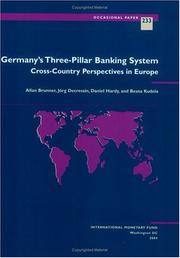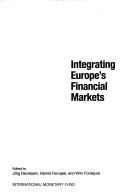| Listing 1 - 10 of 15 | << page >> |
Sort by
|
Book
ISBN: 146232973X 1452747202 128211171X 9786613803900 1451899890 Year: 1999 Publisher: Washington, D.C. : International Monetary Fund,
Abstract | Keywords | Export | Availability | Bookmark
 Loading...
Loading...Choose an application
- Reference Manager
- EndNote
- RefWorks (Direct export to RefWorks)
This paper investigates income redistribution and risk sharing among Italy’s regions and the implications for public policy. Using a richer data set than in previous works, this study allows for an assessment of public consumption’s and investment’s roles. The findings suggest that Italy’s fiscal system provides interregional redistribution at 30–35 percent and risk sharing at 20–30 percent of GDP, mainly through public consumption. Compared with results in the literature for other European countries, there appears to be less redistribution and risk sharing in Italy through its welfare and tax systems because of their different structures.
Macroeconomics --- Public Finance --- Fiscal Policy --- Taxation and Subsidies: Externalities --- Redistributive Effects --- Environmental Taxes and Subsidies --- National Government Expenditures and Related Policies: General --- Regional Economic Activity: Growth, Development, and Changes --- Personal Income, Wealth, and Their Distributions --- Macroeconomics: Consumption --- Saving --- Wealth --- National Government Expenditures and Welfare Programs --- Public finance & taxation --- Personal income --- Consumption --- Expenditure --- Fiscal stance --- Disposable income --- National accounts --- Fiscal policy --- Social assistance spending --- Income --- Economics --- Expenditures, Public --- National income --- Italy
Book
ISBN: 1462328520 1451872747 9786612843419 1452769249 1282843419 Year: 2009 Publisher: Washington, D.C. : International Monetary Fund,
Abstract | Keywords | Export | Availability | Bookmark
 Loading...
Loading...Choose an application
- Reference Manager
- EndNote
- RefWorks (Direct export to RefWorks)
A fear about EMU was that in the absence of national currencies, country-specific shocks would result in greater current account divergences between member states. This paper finds that divergences across euro-area countries are smaller and have not risen relative to those across 13 other advanced economies with more flexible exchange rates. Also, the size of country-specific current account shocks in EMU countries is smaller and their persistence is greater than in the other advanced economies. However, these differences in current account dynamics do not appear related to different exchange rate dynamics.
Foreign exchange rates --- Foreign exchange --- Cambistry --- Currency exchange --- Exchange, Foreign --- Foreign currency --- Foreign exchange problem --- Foreign money --- Forex --- FX (Finance) --- International exchange --- International finance --- Currency crises --- Exports and Imports --- Foreign Exchange --- Current Account Adjustment --- Short-term Capital Movements --- International economics --- Currency --- Current account --- Real exchange rates --- Current account balance --- Real effective exchange rates --- Exchange rates --- Balance of payments --- Germany
Book
ISBN: 1462334741 1452739102 1282108220 9786613801579 1451902387 Year: 2000 Publisher: Washington, D.C. : International Monetary Fund,
Abstract | Keywords | Export | Availability | Bookmark
 Loading...
Loading...Choose an application
- Reference Manager
- EndNote
- RefWorks (Direct export to RefWorks)
The paper compares the degree of capital market integration across euro-area countries with that across regions in Italy and provinces in Canada. Analyzing saving-investment correlations, and developing as well as fitting to the data a model of capital flows, reveal no compelling differences between the integration across countries before monetary union and that across the regions or provinces. The evidence does not suggest that EMU will prompt a major reallocation of net capital flows within the euro area that would entail sizable shifts in countries’ equilibrium current accounts.
Banks and Banking --- Exports and Imports --- Finance: General --- Production and Operations Management --- Current Account Adjustment --- Short-term Capital Movements --- International Monetary Arrangements and Institutions --- Financial Aspects of Economic Integration --- Macroeconomics: Production --- Interest Rates: Determination, Term Structure, and Effects --- General Financial Markets: General (includes Measurement and Data) --- International economics --- Finance --- Macroeconomics --- Current account --- Productivity --- Real interest rates --- Capital market integration --- Capital markets --- Balance of payments --- Production --- Financial services --- Economic integration --- Financial markets --- Industrial productivity --- Interest rates --- International economic integration --- Capital market --- Italy
Book
ISBN: 1462386199 1452722951 1282108069 9786613801418 1451903200 Year: 2002 Publisher: Washington, D.C. : International Monetary Fund,
Abstract | Keywords | Export | Availability | Bookmark
 Loading...
Loading...Choose an application
- Reference Manager
- EndNote
- RefWorks (Direct export to RefWorks)
This paper investigates wage setting in (west) Germany using the German Socioeconomic Panel dataset on individuals and compares the findings with those available for the United Kingdom and the United States. The fraction of job stayers in (west) Germany who suffer unchanged wages or wage cuts compares with that in similar data for the Anglo-American countries, even after various adjustments for potential reporting errors. While nominal wages of job stayers are rigid downward, real wages are not. Nevertheless, the macroeconomic effects of the nominal rigidity are limited and cannot be weakened substantially by raising inflation.
Inflation --- Labor --- Employment --- Unemployment --- Wages --- Intergenerational Income Distribution --- Aggregate Human Capital --- Aggregate Labor Productivity --- Price Level --- Deflation --- Monetary Policy --- Wages, Compensation, and Labor Costs: General --- Labour --- income economics --- Macroeconomics --- Civil service & public sector --- Wage adjustments --- Real wages --- Civil service --- Prices --- United Kingdom --- Income economics
Book
ISBN: 1462316875 1452760411 Year: 2009 Publisher: Washington, D.C. : International Monetary Fund,
Abstract | Keywords | Export | Availability | Bookmark
 Loading...
Loading...Choose an application
- Reference Manager
- EndNote
- RefWorks (Direct export to RefWorks)
This paper discusses deflation risks and policy options. The paper highlights that slumping collateral values have exacerbated the credit crunch, and monetary policy has lost effectiveness in stabilizing output. A model-based analysis for the G3 economies (United States, euro area, and Japan) also suggests that, on the assumption that the financial distress is gradually resolved, the most likely outcome is that the global economy will stay clear of sustained deflation. However, if financial sector problems are not remedied or further shocks add to current stresses, there is a significant probability of more negative deflationary outcomes, with a deeper and more prolonged recession. The chapter underscores the crucial role of financial sector policies in remedying deflationary pressures directly and indirectly, by enhancing the effectiveness of monetary and fiscal policies. Monetary policy can help in some areas; however, supportive fiscal policies are likely to be needed to prevent a deflationary episode becoming entrenched. Monetary policy measures include operating in a broad range of financial markets to relieve credit rationing, and to lower risk spreads and term premiums. Finally, to reinforce long-run inflation expectations, central bank communications should emphasize the commitment to return inflation to objectives with all due speed.
Banks and Banking --- Inflation --- Macroeconomics --- Price Level --- Deflation --- Interest Rates: Determination, Term Structure, and Effects --- Banks --- Depository Institutions --- Micro Finance Institutions --- Mortgages --- Banking --- Finance --- Real interest rates --- Central bank policy rate --- Prices --- Financial services --- Asset prices --- Interest rates --- Banks and banking --- United States

ISBN: 1589062272 9781589062276 Year: 2003 Volume: 221 Publisher: Washington (D.C.) IMF
Abstract | Keywords | Export | Availability | Bookmark
 Loading...
Loading...Choose an application
- Reference Manager
- EndNote
- RefWorks (Direct export to RefWorks)
Money. Monetary policy --- Deflation (Finance) --- Monetary policy. --- Prices. --- 336.748 --- deflation --- crise financiere --- politique monetaire --- politique des prix --- 336.748.14 deflatie --- Economic policy --- AA* / International - Internationaal --- CN / China - Chine --- DE / Germany - Duitsland - Allemagne --- JP / Japan - Japon --- 333.842 --- 331.31 --- 333.841 --- 330.05 --- 332.41 --- Economic nationalism --- Economic planning --- National planning --- State planning --- Economics --- Planning --- National security --- Social policy --- Disinflation --- Finance --- Koopkracht van het geld. Geldontwaarding. Stagflatie. Inflatie. Deflatie. Devaluatie --- deflatie --- financiele crisis --- monetair beleid --- prijsbeleid --- Deflatie. --- Economisch beleid. --- Inflatie. --- Working papers --- Deflation (Finance). --- 336.748 Koopkracht van het geld. Geldontwaarding. Stagflatie. Inflatie. Deflatie. Devaluatie --- Monetary policy --- Prices --- Commercial products --- Commodity prices --- Justum pretium --- Price theory --- Consumption (Economics) --- Cost --- Costs, Industrial --- Money --- Cost and standard of living --- Supply and demand --- Value --- Wages --- Willingness to pay --- Monetary management --- Currency boards --- Money supply --- Economisch beleid --- Inflatie --- Deflatie

ISBN: 1589063481 9781589063488 Year: 2004 Volume: 233 Publisher: Washington, D.C. IMF
Abstract | Keywords | Export | Availability | Bookmark
 Loading...
Loading...Choose an application
- Reference Manager
- EndNote
- RefWorks (Direct export to RefWorks)
Private finance --- Germany --- Banks and banking --- banques --- secteur prive --- secteur public --- allemagne --- -Banks and banking --- -AA* / International - Internationaal --- DE / Germany - Duitsland - Allemagne --- 333.139.2 --- 333.101 --- 333.130.3 --- 333.106 --- 330.05 --- 332.1094 --- Ha1.ideu --- Agricultural banks --- Banking --- Banking industry --- Commercial banks --- Depository institutions --- Finance --- Financial institutions --- Money --- banken --- prive-sector --- openbare sector --- duitsland --- Bankcontrole en -reglementering. Reglementering van het bankberoep. --- Banksysteem en bankstelsel. --- Kapitaal van de banken. Eigen fondsen van de banken. --- Kost, rendabiliteit en concurrentie in de banken. --- Working papers --- AA* / International - Internationaal --- Banksysteem en bankstelsel --- Kost, rendabiliteit en concurrentie in de banken --- Kapitaal van de banken. Eigen fondsen van de banken --- Bankcontrole en -reglementering. Reglementering van het bankberoep --- Banks and banking - Germany. --- Banks and banking - Europe.

ISBN: 9781589066236 1589066235 1462388574 9786613847096 145279474X 1451931751 1283534649 9781451931754 Year: 2007 Publisher: Washington IMF
Abstract | Keywords | Export | Availability | Bookmark
 Loading...
Loading...Choose an application
- Reference Manager
- EndNote
- RefWorks (Direct export to RefWorks)
By and large, EU financial integration has been a success story. Still, the reform agenda is far from finished. What are the remaining challenges going forward? What are the gains of closer financial market integration? This IMF book tracks the European Union's journey along the path to a single financial market and identifies the challenges and priorities that remain ahead. It pays particular attention to the most recent integration efforts in the European Union following the introduction of the euro. The study looks at the importance of financial integration, in particular for economic growth, the interplay between banks and markets, and equity market integration. It closely examines the relationship between financial integration and financial stability. This interaction presents the EU with a challenge, but also with the opportunity to play a pioneering role in developing a regional approach to financial stability that could provide lessons for the rest of the world.
Private finance --- Europe --- Finance --- Capital market --- Financial institutions --- Finances --- Marché financier --- Institutions financières --- European Union --- Economic integration. --- Business & Economics --- Economic History --- 339.7 --- eenheidsmarkt --- europa --- financiele markten --- 333.102 --- 333.602 --- 333.610 --- 334.151.28 --- EEC / European Union - EU -Europese Unie - Union Européenne - UE --- -Finance --- -332.094 --- Financial intermediaries --- Lending institutions --- Associations, institutions, etc. --- Funding --- Funds --- Economics --- Currency question --- Internationale financien. Buitenlands betalingsverkeer --(z.o {336}) --- marché unique --- europe --- marchés financiers --- Bankconcentratie. --- Activiteiten en evolutie van de financiële markten. --- Effectenbeurzen: algemeenheden. --- Kredietinstellingen in de Europese Gemeenschappen. --- 339.7 Internationale financien. Buitenlands betalingsverkeer --(z.o {336}) --- Marché financier --- Institutions financières --- Capital markets --- Market, Capital --- E.U. --- Loans --- Money market --- Securities --- Crowding out (Economics) --- Efficient market theory --- 332.094 --- Bankconcentratie --- Activiteiten en evolutie van de financiële markten --- Effectenbeurzen: algemeenheden --- Kredietinstellingen in de Europese Gemeenschappen --- European Union countries --- Banks and Banking --- Finance: General --- Financial Risk Management --- Investments: Stocks --- Industries: Financial Services --- Accounting --- Investments: General --- Insurance --- General Financial Markets: General (includes Measurement and Data) --- Banks --- Depository Institutions --- Micro Finance Institutions --- Mortgages --- General Financial Markets: Government Policy and Regulation --- Financial Institutions and Services: Government Policy and Regulation --- Pension Funds --- Non-bank Financial Institutions --- Financial Instruments --- Institutional Investors --- Bankruptcy --- Liquidation --- Banking --- Investment & securities --- Economic & financial crises & disasters --- Insurance & actuarial studies --- Macroeconomics --- Financial reporting, financial statements --- Stock markets --- Financial sector stability --- Financial integration --- Financial services --- Financial markets --- Financial sector policy and analysis --- Competition --- Banks and banking --- Financial services industry --- Stock exchanges --- International finance --- United States
Book
ISBN: 1462309410 1452759197 1283517019 9786613829467 1451911904 Year: 2007 Publisher: Washington, D.C. : International Monetary Fund,
Abstract | Keywords | Export | Availability | Bookmark
 Loading...
Loading...Choose an application
- Reference Manager
- EndNote
- RefWorks (Direct export to RefWorks)
Most financial institutions in the European Union (EU) are still based in one country, but a number of large financial institutions (LCFI) have systemic cross-border exposures. The paper explains how, despite much progress, nationally-segmented supervisory frameworks and national accountability for financial stability hinder optimization across borders of banks' operations and efficient and effective LCFI supervision. A full-fledged EU-level prudential regime that operates along-side national regimes--a European Banking Charter (EBC)--could harness market forces to establish a level playing field for financial sector competition, while plugging some significant gaps in Europe's financial stability framework without concentrating excessive powers.
Banks and Banking --- Finance: General --- Financial Risk Management --- Banks --- Depository Institutions --- Micro Finance Institutions --- Mortgages --- Financial Institutions and Services: Government Policy and Regulation --- General Financial Markets: Government Policy and Regulation --- Financial Crises --- Bankruptcy --- Liquidation --- General Financial Markets: General (includes Measurement and Data) --- Economic & financial crises & disasters --- Finance --- Banking --- Financial sector stability --- Deposit insurance --- Financial crises --- Solvency --- Financial sector policy and analysis --- Competition --- Financial markets --- Banks and banking --- Financial services industry --- Crisis management --- Debt --- United States --- Banks and banking, European --- Financial institutions --- Banking law --- State supervision.
Book
ISBN: 1462380484 1452719063 1451975481 Year: 2005 Publisher: Washington, D.C. : International Monetary Fund,
Abstract | Keywords | Export | Availability | Bookmark
 Loading...
Loading...Choose an application
- Reference Manager
- EndNote
- RefWorks (Direct export to RefWorks)
A rules-based fiscal framework, such as the EU’s Stability and Growth Pact (SGP), can be an important bulwark against short-sighted policies. Although policies have improved following the SGP’s adoption, shortcomings remain. These, however, are rooted in the policies rather than the rules, where few changes seem necessary. Specifically, the Excessive Deficit Procedure needs a stronger focus on policies rather than outcomes, while staying operationally simple and transparent. Furthermore, reforms are needed to foster time-consistent national policies, budgetary transparency, and ownership of the Pact. Accordingly, parliaments should debate national Stability Programs and national fiscal councils should review these programs for parliaments.
Macroeconomics --- Public Finance --- Data Processing --- Policy Objectives --- Policy Designs and Consistency --- Policy Coordination --- Fiscal Policy --- National Budget, Deficit, and Debt: General --- Data Collection and Data Estimation Methodology --- Computer Programs: General --- Institutions and the Macroeconomy --- Data capture & analysis --- Fiscal policy --- Data processing --- Fiscal governance --- Fiscal rules --- Structural reforms --- Economic and financial statistics --- Macrostructural analysis --- Electronic data processing --- Greece
| Listing 1 - 10 of 15 | << page >> |
Sort by
|

 Search
Search Feedback
Feedback About UniCat
About UniCat  Help
Help News
News